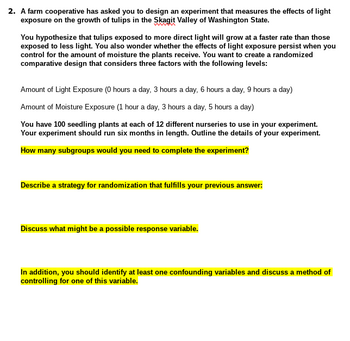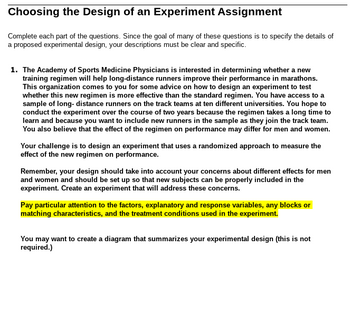
MATLAB: An Introduction with Applications
6th Edition
ISBN: 9781119256830
Author: Amos Gilat
Publisher: John Wiley & Sons Inc
expand_more
expand_more
format_list_bulleted
Question
thumb_up100%
Please help me with these 2 questions.Help is very much appreciated!!

Transcribed Image Text:2. A farm cooperative has asked you to design an experiment that measures the effects of light
exposure on the growth of tulips in the Skagit Valley of Washington State.
You hypothesize that tulips exposed to more direct light will grow at a faster rate than those
exposed to less light. You also wonder whether the effects of light exposure persist when you
control for the amount of moisture the plants receive. You want to create a randomized
comparative design that considers three factors with the following levels:
Amount of Light Exposure (0 hours a day, 3 hours a day, 6 hours a day, 9 hours a day)
Amount of Moisture Exposure (1 hour a day, 3 hours a day, 5 hours a day)
You have 100 seedling plants at each of 12 different nurseries to use in your experiment.
Your experiment should run six months in length. Outline the details of your experiment.
How many subgroups would you need to complete the experiment?
Describe a strategy for randomization that fulfills your previous answer:
Discuss what might be a possible response variable.
In addition, you should identify at least one confounding variables and discuss a method of
controlling for one of this variable.

Transcribed Image Text:Choosing the Design of an Experiment Assignment
Complete each part of the questions. Since the goal of many of these questions is to specify the details of
a proposed experimental design, your descriptions must be clear and specific.
1. The Academy of Sports Medicine Physicians is interested in determining whether a new
training regimen will help long-distance runners improve their performance in marathons.
This organization comes to you for some advice on how to design an experiment to test
whether this new regimen is more effective than the standard regimen. You have access to a
sample of long-distance runners on the track teams at ten different universities. You hope to
conduct the experiment over the course of two years because the regimen takes a long time to
learn and because you want to include new runners in the sample as they join the track team.
You also believe that the effect of the regimen on performance may differ for men and women.
Your challenge is to design an experiment that uses a randomized approach to measure the
effect of the new regimen on performance.
Remember, your design should take into account your concerns about different effects for men
and women and should be set up so that new subjects can be properly included in the
experiment. Create an experiment that will address these concerns.
Pay particular attention to the factors, explanatory and response variables, any blocks or
matching characteristics, and the treatment conditions used in the experiment.
You may want to create a diagram that summarizes your experimental design (this is not
required.)
Expert Solution
This question has been solved!
Explore an expertly crafted, step-by-step solution for a thorough understanding of key concepts.
This is a popular solution
Trending nowThis is a popular solution!
Step by stepSolved in 5 steps

Knowledge Booster
Similar questions
- I just paid 5 bucks to see the hidden answer to number 6, and it's not even here.arrow_forwardI am doing math right now, and I am in the middle of taking a test. I do not want to look up the answer but this test is important to get my grade up. The question is 12x over 45x multiplied by 20 over 6x. Please help me out!!arrow_forward
arrow_back_ios
arrow_forward_ios
Recommended textbooks for you
 MATLAB: An Introduction with ApplicationsStatisticsISBN:9781119256830Author:Amos GilatPublisher:John Wiley & Sons Inc
MATLAB: An Introduction with ApplicationsStatisticsISBN:9781119256830Author:Amos GilatPublisher:John Wiley & Sons Inc Probability and Statistics for Engineering and th...StatisticsISBN:9781305251809Author:Jay L. DevorePublisher:Cengage Learning
Probability and Statistics for Engineering and th...StatisticsISBN:9781305251809Author:Jay L. DevorePublisher:Cengage Learning Statistics for The Behavioral Sciences (MindTap C...StatisticsISBN:9781305504912Author:Frederick J Gravetter, Larry B. WallnauPublisher:Cengage Learning
Statistics for The Behavioral Sciences (MindTap C...StatisticsISBN:9781305504912Author:Frederick J Gravetter, Larry B. WallnauPublisher:Cengage Learning Elementary Statistics: Picturing the World (7th E...StatisticsISBN:9780134683416Author:Ron Larson, Betsy FarberPublisher:PEARSON
Elementary Statistics: Picturing the World (7th E...StatisticsISBN:9780134683416Author:Ron Larson, Betsy FarberPublisher:PEARSON The Basic Practice of StatisticsStatisticsISBN:9781319042578Author:David S. Moore, William I. Notz, Michael A. FlignerPublisher:W. H. Freeman
The Basic Practice of StatisticsStatisticsISBN:9781319042578Author:David S. Moore, William I. Notz, Michael A. FlignerPublisher:W. H. Freeman Introduction to the Practice of StatisticsStatisticsISBN:9781319013387Author:David S. Moore, George P. McCabe, Bruce A. CraigPublisher:W. H. Freeman
Introduction to the Practice of StatisticsStatisticsISBN:9781319013387Author:David S. Moore, George P. McCabe, Bruce A. CraigPublisher:W. H. Freeman

MATLAB: An Introduction with Applications
Statistics
ISBN:9781119256830
Author:Amos Gilat
Publisher:John Wiley & Sons Inc

Probability and Statistics for Engineering and th...
Statistics
ISBN:9781305251809
Author:Jay L. Devore
Publisher:Cengage Learning

Statistics for The Behavioral Sciences (MindTap C...
Statistics
ISBN:9781305504912
Author:Frederick J Gravetter, Larry B. Wallnau
Publisher:Cengage Learning

Elementary Statistics: Picturing the World (7th E...
Statistics
ISBN:9780134683416
Author:Ron Larson, Betsy Farber
Publisher:PEARSON

The Basic Practice of Statistics
Statistics
ISBN:9781319042578
Author:David S. Moore, William I. Notz, Michael A. Fligner
Publisher:W. H. Freeman

Introduction to the Practice of Statistics
Statistics
ISBN:9781319013387
Author:David S. Moore, George P. McCabe, Bruce A. Craig
Publisher:W. H. Freeman